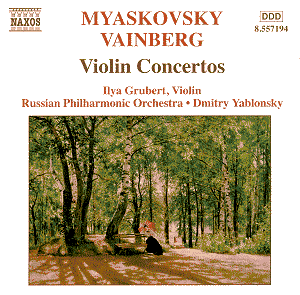Both Miaskovsky and
Vainberg were significant figures in
Soviet musical life, though in the case
of the latter (see below) his career
was somewhat more extensive and cosmopolitan.
This enterprising Naxos issue brings
their skilfully written violin concertos
into contention, and the enterprise
proves thoroughly worthwhile.
Miaskovsky is best
known as the composer of 27 symphonies.
They are works of substance in every
sense of that word. So too the Violin
Concerto he wrote for the great David
Oistrakh in 1938. With a playing time
of some forty minutes the real challenge
in performing this piece is to sustain
the music’s scope and scale, of justifying
the vision. It is a challenge that this
recorded performance manages, if only
just. It is dangerous, admittedly, to
be really sure about this without studying
the work carefully and closely, but
it does seem to be the case.
The approach of Miaskovsky
the symphonist is mirrored in this concerto,
particularly so in the twenty-minute
first movement. There is a sure sense
of lyrical line from the collaboration
of Ilya Grubert and Dmitry Yablonsky,
the soloist and conductor. The booklet
proclaims the recording to be the product
of the ‘Merging Technologies Pyramix’
system, no less, but the sound is not
particularly strong, vivid, or atmospheric.
If anything the acoustic is wanting
in presence. What is more successful
is the balancing of solo and ensemble,
which for once in a concerto recording
affords the violin a realistic perspective
and size.
Ilya Grubert is a young
player of impeccable credentials, with
a most pleasing lyrical line and tone.
If there is not a strong priority of
virtuosity that is because for Miaskovsky
the development of the musical material
is always paramount. For this reason,
perhaps, it is the central slow movement,
a beautifully eloquent Adagio molto
cantabile, that makes the most pleasing
impression.
As for more instant
impressions, the Vainberg Concerto starts
imposingly, with a striking rhythmic
impact. Shostakovich was an early admirer
of the piece, describing it as ‘a magnificent
work’. In fact he admired Vainberg as
a musician and as a man, and even interceded
on the latter’s behalf when he was arrested
as ‘an enemy of the people’ by the Communist
authorities in 1953. Per Skans, in his
excellent insert note, suggests that
Vainberg might not have survived had
it not been for the death of Stalin
that year. Vainberg was of Polish-Jewish
descent, as his name reveals, and came
to Russia at the end of the 1930s when
he fled the Nazi threat. He lived on
into the post-Glasnost era.
The back cover of this
Naxos issue proclaims the Vainberg Concerto
as ‘a large-scale work’, and so it is,
though it must be said that its four
movements turn out to be a good ten
minutes shorter than Miaskovsky’s three
movements. But the Vainberg Concerto
is a fine composition that justifies
its thirty-minute span most convincingly.
The stirring opening bars set the tone
and there is always an imaginative relationship
between solo and orchestra. The development
of the material reveals a composer steeped
in classical procedures, and possessed
of a sure technique, an important consideration
in a concerto. There are some telling
orchestral touches, such as the distinctive
roles accorded to harp and celesta,
but as in the Miaskovsky Concerto one
has the feeling that more rehearsal
time might have paid dividends. This
is hardly music that the orchestra will
have known intimately.
The Russian Philharmonic
Orchestra is another case of the creation
of a new ensemble for the purposes of
recording, but an ensemble who regularly
work together. The Russians have always
had a tendency for creating new ensembles
as and when required, and these days
the standard of the playing is high
even if the results do not sound as
distinctively Russian as they once did.
Despite these various
caveats this is another appealing bargain
from Naxos, with typically useful accompanying
documentation. Vainberg in particular
is a composer we seldom get the chance
to hear, and his Violin Concerto is
undoubtedly worth hearing. Shostakovich,
for one, thought so.
Terry Barfoot
Another appealing bargain
from Naxos … the Vainberg Violin Concerto
is undoubtedly worth hearing. … see
Full Review
